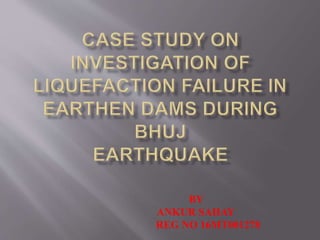
Case study of dam failure ppt by ankur sahay
- 1. BY ANKUR SAHAY REG NO 16MT001278
- 2. INTRODUCTION A Magnitude 7.6 (Mw 7.6) earthquake occurred in Gujarat state, India on 26 January 2001. The epicenter of the main shock of the event was near Bachau at 23.36°N and 70.34°E with a focal depth of about 23.6 km. The event, commonly referred to as the Bhuj Earthquake, was among the most destructive earthquakes that affected India. A large number of small-to moderate-size earthen dams and reservoirs, constructed to fulfill the water demand of the area, were affected by Bhuj Earthquake. Most of these dams are embankment dams constructed across discontinuous ephemeral streams. Although many of these dams were within 150 km of the epicenter (Figure 1), the consequences of the damage caused by the earthquake to these facilities were relatively light primarily because the reservoirs were nearly empty during the earthquake. Nature of damage to the embankment dams within the epicentral region.
- 4. Performance of such structures during Bhuj Earthquake has been examined here. Among these, Chang Dam was underwent almost a complete collapse mainly because of liquefaction of shallow foundation soils. Damage to Fatehgadh Dam was relatively less severe. Direct evidence of liquefaction was not found near Fatehgadh Dam.However, localized liquefaction of foundation soils was one of the causes of the observed post-earthquake distress within these dams. OBSERVED DAM PERFORMANCE A brief summary of the performance of the dams is provided in the following subsections. For a more detailed account of the post-earthquake damage survey at dam sites reference may be made to the EERI (2001) Reconnaissance Report. CHANG DAM Chang Dam, constructed in 1959, is an earth dam with 15.5 m height at its maximum section and 370 m crest length (Figure 2). No site-specific information was available about the subsurface soils other than the qualitative information that the site is underlain by alluvial, loose to medium dense, sand-silt mixtures over shallow sandstone bedrock. Liquefaction susceptibility of the foundation soils was not considered in the original design.
- 5. Chang Reservoir was nearly empty at the time of Bhuj Earthquake. However the alluvium soils underneath the dam were possibly in a saturated state at that time. Bhuj Earthquake caused an almost complete collapse of the dam including damages to the impervious core and the masonry wall . Sand boils were observed near the upstream toe of Chang Dam following the earthquake. The deformation pattern is in fact indicative of a widespread liquefaction within the foundation soils.
- 7. FATEHGADH DAM Fatehgadh Dam, constructed in 1979, is an earth dam with a maximum height of 11.6 m and crest length of 4050 m (Figure 4). Like Chang Dam, Fatehgadh Dam is also underlain by loose to medium dense silt sand mixtures. Fatehgadh Reservoir was nearly empty during Bhuj Earthquake. However the alluvium soils underneath the upstream portion of the dam was saturated at that time. Bhuj Earthquake triggered failure near the bottom portion of upstream slope (EERI 2001) possibly because of localized liquefaction near the upstream toe of the dam. The EERI (2001) also found cracks as deep as 1.5 to 1.7 m within the upstream portion of the dam and instability near the top portion of the downstream slope following the earthquake. The problem of appearance of longitudinal cracks may indirectly relate to liquefaction of foundation soils. However, instability of the upper portion of the downstream slope may not be due to the liquefaction of foundation soils.
- 8. The results of assessment of liquefaction susceptibility of the foundation soils underneath Chang Dam and Fatehgadh Dam are presented in table 2. These results indicate that, if saturated, the foundation soils are susceptible to liquefaction. The procedure for assessing liquefaction potential typically uses the Cyclic Resistance Ratio (CRR) as a measure of the liquefaction resistance of soils and the Critical Stress Ratio (CSR) as a measure of earthquake load.
- 10. CONCLUSIONS Damaging effects of Bhuj Earthquake on embankment dams have been considered in this paper with particular reference to Chang Dam and Fatehgadh dam. Liquefaction to various extents of the foundation soils underneath these embankment dams during Bhuj Earthquake have been reported as one of the major causes of the distress within these dams. The data presented in this paper indicate that liquefaction within the shallow foundation soils would have been widespread underneath Chang Dam, while that underneath Fatehgadh Dam was relatively localized. This assessment is in qualitative agreement with the facts that the damage to Chang Dam was near total, while those inflicted on the other dam was relatively less pronounced. REFERENCES Earthquake Engineering Research Institute (EERI). 2001. Bhuj, India Republic Day January 26, 2001 Earthquake Reconnaissance Report.